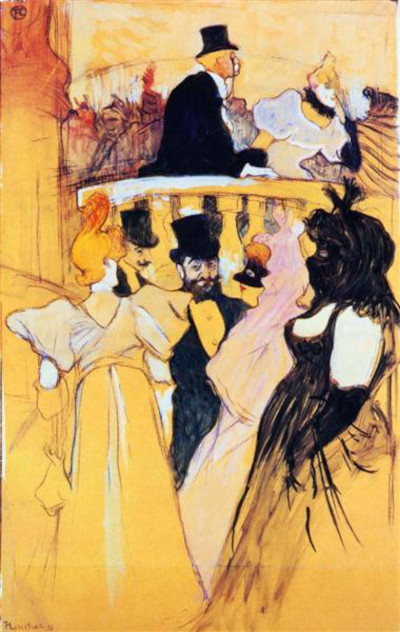At the Opera Ball from 1893 is entirely typical of the style and content found during Toulouse-Lautrec's mature period. The display of leisure time for the middle and upper classes of French society is celebrated in a manner that this artist became so well known for.
Toulouse Lautrec was from wealthy origins himself, but the problems that he suffered throughout his lifetime gave him a sensitivity to those in other parts of society. He could therefore fit into different social groups, and would be welcomed as an artist by all manner of different Parisiens. In this case he focuses on well established figures enjoying a night out at the Opera. We find examples of the smart and glamorous clothing that would be worn to these formal evenings as well as to gain a little feeling for the atmosphere too. Several men and women in the foreground congregate, whilst at the top, behind a rail, others dance and drink. Some of the forms in this piece are unfilled, just with shapes produced from line, with the artist just focusing on detail of the key figures within the painting. See how the dresses in front of us are left blank, but the upper sections receive more attention. Part of the theatre architecture is included along the left hand side, but again mainly with outlines rather than precise detail.
Figurative work was an important part of Toulouse-Lautrec's output. He would feature women particularly regularly, and had favourite models which included a number of stars of stage. Moulin Rouge: La Goulue, Divan Japonais and Jane Avril are some of the best examples of his work, and these remain key contributions to French art in the late 19th century. This was an exciting period in which new ideas came to the canvas, and reflected changes within society itself, with more and more families starting to enjoy leisure activities for the very first time. Artists from across Europe and even as far afield as the US would move to Paris in order to become a part of this exciting period.
The 1893 artwork, At the Opera Ball, is believed to reside within a private collection today and, as such, relatively little is known about it. Thankfully, a large amount of this artist's work can be found within public galleries and museums, allowing the public to continue to see it today, often without having to pay anything to do so. There is a museum, for example, that was set up in his honour and this holds a large selection of his work. It is based in the south of France and holds many items which the family donated in order to protect his own legacy. It is rare for any artist to get a museum in their honour which is still being run successfully a century or more after their death, and this underlines the importance of this artist's career, whose style is still highly regarded today.




